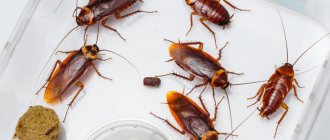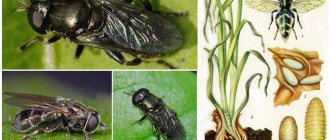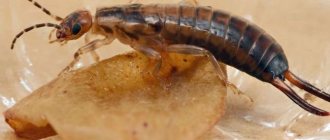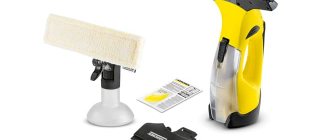Earwigs or double-tailed birds evoke feelings of disgust, disgust and even fear. The insect has an unpleasant appearance - a long body, two sharp swords at the end, protruding mustaches, creating the appearance of a monster, when you look at it you want to immediately leave the room.
But do not be afraid, this creature is not as dangerous as it seems.
The earwig order is a widespread family, representatives of which can be found everywhere - at home, in gardens, vegetable gardens, outbuildings and many other places.
To understand who they are, it is worth carefully considering the appearance, species, habitats, reproductive characteristics and other qualities of insects.
Why is the earwig called that?
There is a legend among people that an earwig can crawl into a sleeping person's ear and pierce the membrane. As a result of this, it penetrates the brain, begins to slowly feed, and this leads to death.
By feeding on the brain, the insect grows. All this, of course, is not true. But the legend is so rooted that even a group of creatures received a name - earwigs.
The legend contradicts the truth and it is not clear why the insect is called an earwig. It does not get into people's ears and does not cause harm. If you pick it up, you might pinch it in self-defense. The bite can only be dangerous for allergy sufferers.
At the rear end of the body, the creatures have characteristic processes that resemble forceps. This gave rise to the second name of the insect - the two-tailed or two-tailed cockroach.
It uses these limbs as weapons for self-defense. When danger approaches, the double-tailed snake puts its shoots in the direction of the threat and can strongly pinch with them.
Lifestyle
The earwig leads a hidden lifestyle, hiding during the day under stones, fallen trees, as well as under the bark of trees and old stumps. In such shelters, earwigs sometimes accumulate in large numbers. At night, on the contrary, they become very active; crawl out of their daytime shelters and quickly run in search of food, which can be very diverse and the composition of which depends on the characteristics of a particular place. The activity of earwigs is highly dependent on weather conditions. They exhibit the greatest mobility on warm days, when temperature differences between day and night hours are minimal. They prefer cloudy weather, but if there is precipitation, they remain in shelters.
External structure of earwigs
Earwigs belong to the phylum of arthropods, they are representatives of the order of cryptomaxillary. Insects have a small body, the length of which is 2-5 mm. But in nature there are giants with body sizes of 50-60 mm.
They love to inhabit places with high humidity.
To understand the type of insects, it is worth considering the structural features of earwigs:
- they have an oblong body with a flat shape;
- the surface of the body is brown-chestnut in color;
- males are large, their body length can reach 2-4 cm, but females are smaller - the size does not exceed 1.5 cm;
- the outside of the body is covered with a shell with a strong and dense structure;
- Adults develop membranous wings, and some species may have two pairs. But they still prefer to move on the ground;
- on the surface of the head they have small eyes and antennae with a thread-like structure. The latter consist of 11-14 segments;
- the limbs are short and consist of three segments. The insect has three pairs of legs. There are claws at the ends;
- at the end of the body, on the abdominal area, there are claw-shaped processes, which are also often called “pincers”. They are designed to protect and hold prey.
Particular attention should be paid to the type of structure of the oral apparatus of earwigs; they have a gnawing one.
Its design allows you to easily handle food. The mouthparts of the two-tailed fish are directed forward.
Features of the structure of earwig wings
Particular attention should be paid to the wings. They have a specific structure, so many people believe that insects cannot fly, but this is not true.
The wings of earwigs have the following features:
- the front wings are small and fit tightly to the surface of the body;
- have a sclerosed structure, they lack venation;
- the hind wings are hidden under the front wings and have a membranous structure;
- veins are located on their surface in a radial position.
This wing structure keeps the earwig upright in flight. Since the process of unfolding and folding elements is a complex matter, double-tailed birds rarely fly.
When landing, they have to fold their membranous wings twice. For this reason, they prefer to travel by land.
But as for the important question of how many wings earwigs have, the answer can definitely be 4. The fact is that many do not notice the lower pair, because it is hidden under the upper one.
Why are they dangerous?
Why are earwigs dangerous? For humans - practically nothing, except for an occasional unpleasant bite or a rare allergy to a given insect. The pinch is not at all poisonous, and the liquid, sprayed in small quantities, is not poison, but simply a specific aromatic substance.
The pest can cause significant damage to the crop during periods of high fertility. Since the creature is omnivorous, tender seedlings, roots of shrubs, flowers and trees, tips of leaves and flower petals, vegetables, berries and fruits can be destroyed.
Methods of destruction
There are many ways to kill earwigs. It all depends on where you want to get rid of insects: in the house, apartment or in the garden. Methods can be either traditional or using various drugs.
- You can destroy the garden earwig using ordinary wet rags or newspapers. Some kind of traps are laid out around the perimeter of the garden or near the seedlings, and after insects crawl onto the damp cloth, the rags are removed and treated with boiling water along with the insects.
- Earwigs rarely live in a house or apartment, but nevertheless, cases do occur. To combat insects, boiled egg yolk or bran mixed with boric acid and formed into small balls is suitable. Such mixtures are laid out in secluded corners, while carefully protecting children or pets from poisoning.
- The repellent method is also considered effective. Such means are ordinary crayons with a specific odor that repel various types of insects.
- Basil is considered another good defense. Its spicy smell repels nibblers.
- Due to the universal love of insects for sweets, you can prepare containers with sweet contents in the form of syrup. Glass containers are filled a little with sweetness and covered with a lid with a small hole.
- Adhesive fly tape will help catch insects in your home or basement.
- Those who do not like to use chemicals in the garden can lubricate the bottom of the plants with ordinary Vaseline. This barrier will not allow the earwig to crawl through.
- If there is livestock in a flower pot, you can prepare an onion or garlic infusion and spray it on the plants and pots.
To prevent the appearance of these creatures, you should clear the entire perimeter of the vegetable garden or garden from debris, mown grass, withered leaves, stacks of wood, cobblestones and other possible hiding places. You should also water your plants only when necessary and not overwater them, as earwigs are attracted to excess moisture.
No matter how useful and necessary earwigs are in nature, if you encounter them at home, it is still better to get rid of them, because the harm from the insect is many times greater than the benefit! We hope that the tips provided will help solve your problems.
Internal structure
The exact internal structure of the two-vostok has not been established. Insects have a highly developed nervous system; they have many nerve endings throughout the body - on the limbs, posterior cerci, antennae.
Therefore, they are able to sense the approach of danger from a great distance, the same applies when catching prey.
The respiratory organs of earwigs are the trachea. Air enters them through holes located on the sides of the body - spiracles. The inside of the trachea is lined with a thin chitinous film, which has a spiral thickening.
It gives the trachea elasticity and prevents them from flattening. The intake and removal of air is carried out by changing the volume of the abdomen through muscle contraction.
Double-tailed insects
Many people think that earwigs and double-tailed insects are the same insects, but this is not true at all. Although they have a similar appearance, they are considered different creatures.
To understand what distinguishes the inhabitants, it is worth considering the description of each species:
- A photo taken from the Internet will help you understand what a double-tail looks like, but it still won’t be able to tell the difference. Insects belong to the class arthropods. They have a characteristic formation at the end of the body, which looks like claws or tentacles. The insects are small; on average, the body length of adult individuals reaches 5 mm, but sometimes giants with a length of up to 5 cm are found. There is no pigmentation on the segmented abdomen. Insects do not have eyes; their role is played by long antennae with high sensitivity.
- Earwigs are members of the class Leatheroptera. Their body is elongated with a flat shape, its color is brown. The body length of males is on average 1.7-2 cm, and females - up to 1.4 cm. In nature, large individuals with a length of 6-7 cm are found. They have small eyes, wings with a membranous structure and thread-like antennae. They don't fly that often. A distinctive feature of these creatures is the shape of the cerci - the processes have a claw-like appearance and are located at the end of the body.
Video
Double-tailed
Prevention of occurrence
To prevent earwigs from infesting your home, you need to destroy all possible ways for these insects to enter your living space. In addition, it is necessary to ensure that there is no constant source of moisture in the apartment. All taps and pipes are checked for leaks, and if there are any, they are repaired immediately.
Regular loosening of the soil will not only saturate it with oxygen, but also prevent waterlogging. All this will reduce the risk of earwigs. An important role is played by systematic weeding of the site, compliance with recommended planting patterns and timely removal of garbage and plant debris.
The two-tailed dog can enter an apartment in a variety of ways, including fruits and vegetables, as well as other greens, as they are easy to hide in. In addition, there are enough secluded places on a personal plot or in a summer cottage where an insect can hide. It is possible to reduce the likelihood of active reproduction of earwigs if you follow a number of rules. For example:
During the harvesting process, including grapes, berries, fruits and various greens, you need to be careful and check the harvested crop for the presence of various insects. On a personal plot or in a country house, care must be taken to promptly remove fallen leaves, which can serve as shelter for such arthropods. If an earwig is found in the apartment, then first of all you should pay attention to the order in the house
You should not leave leftover food on the dining table, or close jars of water. It is equally important to maintain optimal humidity in the apartment, since double-tailed plants feel excellent at high humidity. It is also important to properly care for indoor plants, avoiding waterlogging of the soil. The greater the accumulation of indoor plants in the apartment, the greater the chance of the two-tailed plant to go unnoticed. Therefore, it is necessary to regularly inspect indoor plants, especially since it is not so difficult to detect, compared to other parasites. Traps show good results
To make the simplest trap, just take a tin can and pour vegetable oil into it, and then install it in the place where the trap appears.
If such arthropods are found in an apartment or house, then it is necessary to urgently take measures to get rid of them. Despite the fact that the earwig does not pose any particular danger to humans, such proximity in an apartment will not bring a feeling of comfort. To get rid of such insects, it is enough to adhere to a number of rules, including using some folk recipes or simple traps, so as not to deal with chemicals.
Types of earwigs
The modern fauna includes about 1,300 species of earwigs, this number exists all over the world, which means that these representatives can be found in every corner of the earth.
The most favorable climate for them is a tropical forest with rich vegetation, warm air with a combination of pleasant moisture. These places are considered the best for their habitat and active reproduction.
On the territory of the countries of the former USSR there are not many varieties of representatives of leatheroptera. There are about 26 species. But we will look at the main ones.
Common earwig
Representatives of the order of earwigs of this species are considered the most common; they can often be found in our country. They are small in size, body length can reach 15-20 mm.
The color of the body is dark brown, there may be reddish shades.
Insects have well-developed muscles that ensure normal movement of the rear mites or cerci.
They know how to use them perfectly, and with their help they can calmly capture and hold prey. And in case of danger, pincers can be used as a spear for protection.
During the daytime, they prefer to hide under stones, in old stumps, or under a layer of wood ash. They can be found in places with high dampness. Common earwigs are active at night and go out in search of food.
The diet of these creatures depends on their habitat:
- Vegetation leaves of trees, young shoots, flowers, cereals, garden crops;
- Fungi that develop under the bark of trees;
- A variety of small insects.
Coastal
This variety is widespread throughout the world. Representatives can live in desert areas, as well as in forest areas.
They are found on the banks of rivers, lakes, and seas, but only if there is a certain type of soil - sandy or sandy loam.
The body structure of insects is no different from common earwigs. They have a small body, its length can be 10-20 mm.
Their coloring is slightly different - dark brown, the lower part of the abdomen, sides, cerci, and limbs are light brown, closer to yellow. The ends of the churches are dark.
Small
Individuals are widespread and can be found almost everywhere. This is the smallest representative of our fauna.
The length of the insect's body can range from 4 to 6.5 mm. That is why it received the name – small.
A distinctive feature is that they are active during the day.
Asian
In Asian animals, the surface of the body is black; there are yellow spots on the area of the elytra and wing plates. The length of the wing plates is 10-16 mm. The pincers are strongly curved. Prefers to lead a daytime lifestyle.
The variety is widespread in Central and Central Asia. It prefers to live in semi-deserts, and in southern areas it can be found in the mountains. Insects feed on plant foods.
They fly from one place to another. Their flight speed is low, but earwigs are able to rise up to 100 meters.
Guinea cave
Insects live in caves where there is no sunlight.
Due to the fact that Guinea cave earwigs are constantly in complete darkness, their appearance has changed:
- their eyes are poorly developed, they practically do not see;
- pale pigmentation is present on the surface of the outer integument;
- long limbs and antennae.
Hemimers
A common species of earwig in tropical Africa. It is classified as a parasite because the insect is found on the surface of the skin of the hamster rat.
The main features of the body structure include:
- the insect has a flat body;
- he has no wings;
- limbs are short;
- They have no organs of vision.
Features of character and lifestyle
Photo: Earwig insect
Earwigs are nocturnal. They hide during the day in dark, damp places such as rocks, plants, huddles, fruits, flowers and other similar places. They emerge at night to hunt or gather food. They are weak flyers and therefore move mainly by crawling and being carried by humans. Earwigs can be considered either solitary or colonial insects. During the mating season, females live alone, but during other months of the year they tend to gather in very large groups.
Earwigs are considered a subsocial species because they provide parental care to their children. When common earwigs feel threatened, they use their pincers as weapons to defend themselves. Adult earwigs release a pheromone that attracts other earwigs. Nymphs also release pheromones that entice mothers to care for them. The tongs are also used as a means of communication during mating and exhibit threatening behavior.
The nighttime activity of earwigs depends on the weather. Stable temperatures stimulate activity, but extremely high temperatures are discouraged. High relative humidity suppresses movement, while higher wind speeds and greater cloud cover stimulate earwig activity. They produce an aggregation pheromone in their excrement that is attractive to both sexes and nymphs, and secrete quinones as defensive chemicals from abdominal glands.
Life cycle
The type of development of the earwig is called incomplete metamorphosis. In a year it is able to live through all stages of development - egg, larva, adult. The female is capable of laying 30-50 eggs at a time. The incubation period is 56-80 days.
At the end of this period, larvae appear, and only then individual earwigs gradually form.
Life expectancy is 1 year; during this period, the female is capable of producing several clutches of eggs.
How do earwigs reproduce?
When considering the characteristic features of the earwig, it is worth paying attention to the reproduction process. Mating lasts 2-3 hours. Then, after two months, the fertilized female makes a tunnel 8 cm long, which ends with an extension.
In this place she breeds and lays eggs. It can lay from 30 to 60 eggs at a time.
At the beginning of March, the earwig lays eggs again, their number is no more than 20 pieces. The first larvae appear at the end of spring, but they reach full maturity only towards the end of the summer season.
When the female lays eggs, she stays close to them, protecting future offspring from danger and uninvited guests. The insect remains until the larvae appear.
Larvae differ from adults in body size, and they also do not have wings. Formation occurs gradually, the individual molts from time to time and slowly turns into a sexually mature insect.
Reproduction
When a female earwig becomes sexually mature, eggs are formed in her body at a certain period.
The earwig develops with incomplete metamorphosis. Mating occurs in late summer - early autumn, and it continues for several hours. A few days later, the female lays eggs in one common pile, in a specially prepared nest. The nest is a passage dug in the ground from 5 to 8 cm long, less often up to 15 cm. Usually the nest passage is made in the form of a straight tube, but sometimes it has a side branch. In this burrow, the female remains to overwinter along with the eggs and after overwintering she lays eggs again. Males usually do not survive winter well, and in the spring you can sometimes find their corpses lying near living females.
The earwig is a caring mother. She chooses different crevices in the ground for her nest; she is especially attracted by the burrows of earthworms, an excellent shelter for eggs and future offspring.
One brood of earwigs contains an average of fifty to sixty eggs. The tender mother not only sits on them until the children come out, but also takes care of them like a hen takes care of her chicks, without leaving her for several weeks.
Its larvae are similar to the female in everything, only small and wingless. She protects her children from enemies whom she can defeat, and then the female dies, and the larvae surrounding her eat the dead body. Then they leave the hole.
Females show a kind of care for the offspring, protecting the eggs until the larvae hatch from them. In this case, the female is positioned in the nest in such a way that she covers the laid pile of eggs with her head and front legs. She has to protect her offspring not only from external enemies, but also from the male and other females who are not averse to occasionally feasting on the laid eggs. Typically, egg development lasts 5 to 6 weeks. The female continues to remain with her offspring for some time after the larvae hatch from the eggs, protecting them. The first instar larvae are similar to adults, differing from them in size, a reduced number of antennal segments (8 instead of 13-14), the absence of wings and a number of other characteristics. After the death of the mother, the larvae lead an independent life.
Habitat of earwigs
The earwig prefers to choose places with high humidity and favorable living conditions. The habitat of fauna representatives should be dark, damp and warm, where the insect will feel comfortable.
The following places are considered the best options:
- rural lands;
- gardens;
- vegetable gardens;
- damp, dark basements;
- Houses;
- apartments with poor ventilation.
The favorite habitats of insects are secluded and inaccessible areas in nature, vegetable gardens, orchards - stones, fallen leaves, piles of manure, cracks in trees, various depressions, fallen trees, firewood.
Preventive measures
There is no need to wait until earwigs appear on the site and you will have to fight them. For the purpose of prevention, work should be carried out to prevent their occurrence:
- Remove everything that can become a haven for insects: old hay or straw, last year's leaves, fallen trees, rotten boards, bark and firewood. The vegetable garden and garden should not be cluttered.
- In the fall, dig the soil deeply in the area, which will result in a decrease in the number of individuals.
- To prevent earwigs from appearing in your home, repair any existing cracks and cracks, check for leaks in the water supply, and keep your home clean and tidy.
Well, if preventive measures did not help, and pests have settled on the site or in the house, then it is worth thinking about ways to combat them.
Diet of earwigs
Insect nutrition includes a variety of components. Earwigs are voracious insects that can feed on both vegetation and insects.
Let's look at what two-tailed or earwigs eat in nature:
- they will happily eat honey, fruits, and vegetables. This is a treat for them.
- Insects are pests in the garden. They are capable of causing serious damage to vegetation - they eat the edges of tree leaves, gnaw through the stems of seedlings, and damage the roots.
- Do not refuse mushrooms, seeds, moss.
- They will not disdain the leftover food that is left on the table.
- Earwigs love flowers - chrysanthemums, dahlias, asters, roses, phlox, poppies.
But there is still some benefit from pests; creatures are able to eat harmful insects that cause damage to plants in the garden.
Their favorite treats are:
- caterpillars;
- flies;
- spider mites;
- aphid.
Two-tailed insects also destroy fallen fruits and eat parasitic fungi.
Therefore, if single individuals are observed on the site, then they do not need to be destroyed, but if you notice a large accumulation of pests, then it is better to take urgent measures to combat them.
Prevention of the appearance of the parasite
It is unlikely that you will be able to avoid an encounter with an arthropod insect: the two-tailed insect often ends up home with grapes, vegetables, herbs, where it is easy to hide from the gaze of an inattentive buyer. The country house is also full of secluded corners where the earwig lives. But you can reduce the likelihood of active reproduction in your garden and in your apartment if you follow a few rules.
Recommendations for summer residents and city residents:
when choosing vegetables, fruits, berries, leafy greens, you need to carefully check whether there are arthropod insects among the bunches of grapes or tops; at the dacha you will have to work hard to remove fallen leaves from the area in time so that the earwig has nowhere to hide and feed; When an “uninvited guest” with sharp “swords” on the back of the body appears in the apartment, you need to be more careful about cleanliness, sweep away all the crumbs from the table, and close the jars of water. Leftover food is a tasty morsel for the earwig: you should always remember this; Excessive humidity in the room is the optimal environment for insect reproduction. If the two-tailed bug breeds, it will be difficult to get rid of it
To prevent the appearance of double tails, you cannot “breed” dampness in the apartment; attention to indoor plants is a condition under which the risk of the appearance and reproduction of harmful insects is reduced several times. The more flowers there are in the room, the higher the risk that one or two individuals or larvae will remain among the greenery
Flower growers should regularly inspect leaves, buds, and check the top layer of soil in the flowerpot. The earwig is a larger insect and is easier to detect than other pests (for example, the dangerous spider mite measures no more than 1 mm); tin can trap. Open the container, remove the contents, wash, dry, pour in vegetable oil, place around the apartment. The two-tailed fish will crawl inside, fall into the oil and not get out.
If an adult earwig is found on ornamental plants in an apartment or among garden beds, you need to immediately inspect the remaining plants in order to get rid of the larvae in time and destroy other insects. Traditional methods and chemicals are suitable for processing. The more the bivost has multiplied, the more powerful the drug should be.
Earwigs in nature
The role of earwigs in nature matters. Insects are considered to be a kind of orderlies, because they eat the remains of dead plants, insects, and also destroy some types of pests.
It is important to remember that in nature everything is interconnected, therefore any insects, animals, creatures can have harmful and beneficial effects. Much depends on living conditions and time of year.
Pincers also have benefits: if they live in gardens and vegetable gardens in moderate quantities, then at night insects will be able to eliminate aphids and other pests from plants.
They also eat pathogenic fungi, which can cause serious damage to fruit and berry plantations, vegetables and other vegetation.
Earwigs have natural enemies:
- birds;
- lizards;
- spiders;
- frogs;
- other insectivorous creatures.
Fighting methods
In the garden or garden
- Pour boiling water over the area where insects accumulate;
- lay out the traps in the form of wet rags on which the two-tails will be collected, then destroy the traps;
- dig the area deeply in the fall, this will help reduce the number of unwanted guests next year;
- Earwigs are afraid of the smell of vinegar; you need to place sponges soaked in vinegar on the area for washing dishes.
Readers interested in earwigs may also find articles about the following pests useful: fruit flies, bedbugs, woodlice, nematodes, cicadas, mole crickets, Colorado potato beetles, dust mites, potato moths.
Danger of insects
Many people are interested in why the earwig is dangerous for people, but it is practically incapable of causing harm to human health. The insect may sometimes bite, and people with allergic reactions may be more sensitive to its bite.
The stinger is not a poisonous creature, and the liquid that it injects at the time of the bite is not poison, it is a specific aromatic substance.
If it was not possible to avoid a bite from this insect, then the affected area can be treated with an antiseptic agent. You can also take an additional antihistamine.
The danger of earwigs can only be to crops. If a large number of these insects live in a vegetable garden or garden, then they can significantly damage trees, seedlings, flowers, fruits, vegetables and other vegetation.
Ridding the garden of pests
You can get rid of earwigs in the garden without harming the crop in the following ways.
- To free your garden or vegetable garden from woodlice and earwigs, you must first of all put it in order. You should get rid of damp places littered with various waste, as well as compost heaps and fallen trees. After all, this is where pests most often live.
- The fight against earwigs will also be effective when digging deep into the soil in late autumn.
- Earwigs can be killed using a trap. It uses a generously dampened rag, a used tin can or an old watering hose. If you find tweezers under a particular item, you should pour boiling water over them.
- It is effective to poison earwigs with poisons. Fufaon, Intavir or Iskra can be used to spray infected plantings. Biological products such as Lepidocide or Bitoxibacillin also give good results.
- You can also remove earwigs using folk remedies. To do this, many use the method of repelling plants that have insecticidal properties. Wormwood, yarrow, tansy or basil are what earwigs fear. A tincture is made from them, to which washing powder or laundry soap is added. This solution is used to treat damaged plants.
However, not all reviews about tweezers are negative. If you find an insect in your garden or vegetable garden, you should not rush to destroy it. In single quantities the pest does not pose a great threat to plants. And even vice versa: it is a destroyer of caterpillars, spider mites, flies, slugs and aphids. Earwigs should be controlled when their numbers become excessive.
Interesting facts about earwigs
If you want to know everything about earwigs, then study interesting facts about these inhabitants of the planet:
- insects live in all corners of the globe, except frosty Antarctica.
- Earwigs are often confused with double-tailed earwigs, but they are considered different creatures. Two-tailed birds belong to the class of cryptognathans, and earwigs belong to the class of insects.
- When curled, they resemble the shape of a human ear.
- Scientists have never encountered true evidence of earwigs getting into human ears.
- A distinctive quality of individuals is the presence of foreps (pairs of pincers) on the back side. Many people are afraid of them, but they cannot cause any harm, much less damage human skin.
- It takes 20-70 days for earwigs to grow from the moment of laying eggs to a sexually mature individual. And their life span is only a year.
- There are 25 species of earwigs in North America, 45 in Europe, and 60 in Australia.
- The largest in history were found on the island of St. Helena. The body of the giant creatures reached 8 cm.
Earwigs are unusual insects that hide many secrets. Despite their unpleasant and threatening appearance, they do not pose a danger to humans. You should not be afraid of their appearance, run away and scream, the creature will not do anything bad.
They harm vegetation in the garden, but only if they live in large numbers.
But at the same time, we should not forget about the benefits of the inhabitants, because they can also destroy harmful organisms that can greatly damage the plantings on the site.
What are the folk methods?
First, you can try fighting insects using traditional methods. Unconventional methods are safe for the environment and animals. It is allowed to use a trap for two hundred, which is based on the insect’s love for high humidity.
To create a trap, you need to generously wet old rags. The cloth should be placed where the insects are most numerous and left overnight. In the morning, you should destroy the trap along with the pests.
When mites appear in indoor plants, treatment should be carried out. Flowerpots and leaves are rubbed with vinegar.
To get rid of earwigs, wipe surfaces in your apartment with vinegar.











